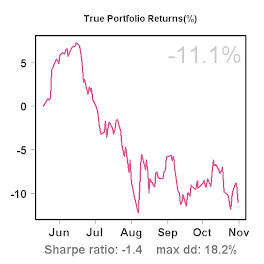Some more analysis
One of the reasons that led to my decision to terminate my portfolio was some analysis I did last week. It was motivated by my experiences in practice: in a few cases I had selected a system with great performance statistics, and it subsequently did quite well in my portfolio; but in other cases the performance was quite disappointing, even though at the time I signed up the system looked great.
So I decided to look at all end-of-day stock systems ever listed on C2 and see how often a "good-looking" system (based on the performance shown on C2) would continue to "look-good" in the future.
I further decided to define "looking-good" as: outperforming the S&P500 index based on the Sharpe ratio. With the underlying idea that I might as well put my money into the SPY (S&P 500 ETF) rather than going through all the trouble of trading if I have no reasonable expectation to get a better Sharpe ratio than the S&P500.
I only included systems with more than 10 trades, and started by taking all systems with a track record of more than half a year. Some of these started way back in 2004, others just 6 months ago; in other words they nicely spread out over time.
Next I downloaded the equity history for each system (using the C2 data api) and calculated the Sharpe ratio for the first 3 months after each system started, and then for months 4-6. What I would hope to see was that systems with a high Sharpe ratio in the first 3 months would also have a high Sharpe ratio in the next 3. Because when that is true, I could pick a system with a high Sharpe ratio as soon as it would have 3 months of track record and expect a nice result for the next 3 months when I would trade it myself!
It turns out, there are 75 end-of-day stock systems with more than 6 months of history. The table below shows the 10 systems with the highest Sharpe ratio for the first 3 months after they were launched:
The table shows that of all end-of-day stock systems ever launched on C2, no one had a Sharpe ratio higher than "Good NEWS Predictor" (4.22) for the first 3 months after inception. Trading it for the next 3 months would turn out to be a good choice, as it got an even higher Sharpe ratio (4.62) for that period. Interestingly, it did actually slightly worse during the first 3 months than the S&P500, as shown in the column Excess Sharpe ratio (i.e. the Sharpe ratio of the system minus the S&P500 Sharpe ratio over the same period). Unfortunately, the other 9 systems were less consistent, as they all did worse in the second period in terms of absolute Sharpe ratio and most did worse as well in terms of excess Sharpe ratio.
In fact--and this is where the trouble starts--half of the systems did worse than the S&P500 in the second period. On average they still outperformed the S&P500 Sharpe ratio by 0.51, but it's a difficult choice between getting the index return for sure, or having a 50/50 chance of out/underperforming the index.
The table also shows that when selecting one of these extremely well-performing systems for the first 3 months, there's a 3/10 chance of ending up with a loss in the next 3 months (negative Sharpe ratio).
As I am planning to show in a subsequent post, the 3 month period is actually a "best-case" scenario: The table looks much worse for many other periods (e.g. 4 months).



No comments:
Post a Comment